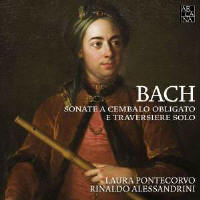Texte paru dans: / Appeared in: |
|
|
Outil de traduction ~ (Très approximatif) |
|
|
Reviewer: Bertil
van Boer
Back in 2015 I reviewed the disc of C. P. E. Bach’s music performed by Laura Pontecorvo (38:4), noting in the interview that she had other projects in mind concerning the Bach family. Here, at long last, is her disc of the complete Johann Sebastian Bach flue sonatas on Arcana, performed with her talented accompanist Rinaldo Alessandrini on the harpsichord. Two of the sonatas, in A Major (BWV 1032) and B Minor (BWV 1030), date from 1736, relatively late in Bach’s career, and he clearly was aware of the importance of the flauto traverso as opposed to the more common flauto or recorder. Both of these works were intended for chamber concerts at the Zimmermann Coffee House in Leipzig, no doubt by members of the University Collegium Musicum, but they were also arrangements themselves of earlier works, possibly the first for oboe in C Major and the latter perhaps for keyboard solo, also originally in G Minor. The E-Minor Sonata (BWV 526) represents a gloss on a trio sonata or duo keyboard, while the G-Major (BWV 1019) was originally meant for the violin, and even shows up in other formats. No matter the convoluted source transmission, all four works have in some sense been reborn as flute sonatas, and in these guises have been considered as Bach’s main contributions for this emerging wind instrument. There are, of course, numerous recordings of these sonatas, most recently Stephen Schultz and Jory Vinikour on Music & Arts, many of which do respectable jobs in presenting this brief repertory. Where Pontecorvo and Alessandrini depart from this company is in the sensitive renditions that seem to mold the lines into a nicely-integrated whole. In the B-Minor Sonata’s opening movement, for example, the line is produced in a languid manner that gives it a lyrical flow, especially in the sequencing, while allowing for an occasional pointed expostulation. The lyrical second movement practically floats musically, with the line unfolding sensuously, while the final Presto trips along with some neat chromatic turns. The A-Major Sonata, with a first movement reconstructed (as all others need to be) by Alessandrini, begins with a powerful solo harpsichord statement that gives the work depth, and when the flute joins in the effect is stately and regal. The slow movement is a mournful aria, with nicely juxtaposed flute and continuo lines echoing each other, and the final Allegro is jaunty and playful with some nice canonic lines between the two instruments. These two sonatas bookend two others where the arrangements are more clear. The G-Major is a bit of a hodgepodge suite, beginning what sounds like a rather fluid prelude, followed by a lamento that expresses deep emotion. The third through fifth are more conventional, exercises that feature rolling lines (and a bit of contemplation in the Adagio fourth). The E-Minor Sonata, originally meant for organ (as a “trio” of registers), opens with a series of sequences that meander about, only to move on into a pensive second with a soft messa di voce flute entrance that begins to unfold into sequences like flowers opening in the spring. The finale is insistent and filled with interesting suspensions. The performance by Pontecorvo is clear, bright, and finely nuanced in terms of discrete ornaments and phrasing. She never wavers in her tone, and whether sustaining notes or performing the rather flowing virtuoso lines she is at all times perfectly aware of the needs of Bach’s often tortuous lines. Alessandrini’s accompaniment is supportive when it needs to be and emerges powerfully in solo sections. I like his instinctive sense of registration that offers textural depth. This is the way Bach should be performed. Highly recommended. | |
|
|
|
|
Cliquez l'un ou l'autre
bouton pour découvrir bien d'autres critiques de CD |
|




